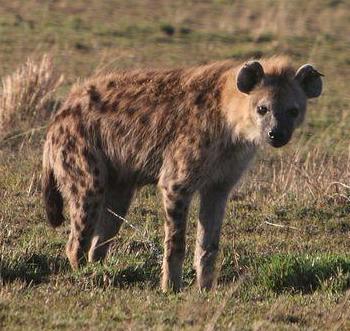Members with the conservation group Lion Guardians stumbled on a rare site in the Amboseli area of Kenya recently: six hyenas and a number of jackals were attacking and eating a 12-foot-long python.
On their blog at WildlifeDirect, Lion Guardians describe the attack: “[the hyenas and jackals] tore into its body from the back, and were taking their share while the upper part of the python was still alive! The Lion Guardian team was shocked and surprised at the same time, having never seen anything like it before.”
A massive drought through Eastern Africa has taken its toll on both predator and prey. With many large prey animals dying due to the drought, big predators are caught in a lurch, having to seek out new food sources to survive.
 Spotted hyena in Kenya. Photo by: Rhett A. Butler. |
According to Lion Guardians, “carnivore starvation in the coming weeks is inevitable. The Amboseli ecosystem has lost over 8 percent of the lion and hyenas’ prey.” While hyenas are turning to pythons—and presumably whatever else they can find—lions are beginning to kill livestock.
Lion Guardians is working with local communities to protect their livestock from lion attacks and in turn save lions from retaliation by locals. Lions are often killed by poison, spear, or gun in revenge for attacks on livestock.
The organization works to mitigate lion-human conflict by working with locals to improve their livestock enclosures, change herding practices, and inform them about lion movements with an early warning system.
Related articles
Prime Minister of Kenya urged to ban lion-killing pesticide after child dies from ingestion
(11/10/2009) On Monday October 26th a three-year-old girl mistakenly ate the pesticide Furadan (also known as carbofuran) in western Kenya. Her father, a teacher at a primary school, said that he had no knowledge of how dangerous the pesticide was, which he had purchased to kill pests in his vegetable garden.
NASA satellite image reveals extent of drought in East Africa
(11/05/2009) A new image from NASA shows the severity of the drought in East Africa, which impacted Tanzania, Kenya, Ethiopia, and Somalia.
Kenya’s pain, part two: decades of wildlife decline exacerbated by drought

(10/20/2009) Not many years ago if you were planning a trip to Africa to see wildlife, Kenya would be near the top of the list, if not number one. Then violent riots in late 2007 and early 2008 leaving a thousand dead tarnished the country’s image abroad. When calm and stability returned, Kenya was again open for tourism, and it’s true that most travelers were quick to forget: articles earlier this year announced that even with the global economic crisis Kenya was expecting tourism growth. However, a new disaster may not be so quickly overcome.
Kenya’s pain: famine, drought, government ambivalence cripples once stable nation

(09/17/2009) Kenya was once considered one of Sub-Saharan Africa’s success stories: the country possessed a relatively stable government, a good economy, a thriving tourist industry due to a beautiful landscape and abundant wildlife. But violent protests following a disputed election in 2007 hurt the country’s reputation, and then—even worse—drought and famine struck the country this year. The government response has been lackluster, the international community has been distracted by the economic crisis, and suddenly Kenya seems no longer to be the light of East Africa, but a warning to the world about the perils of ignoring climate change, government corruption, and the global food and water shortages.
Lion population in Kenya could disappear in 10 to 20 years
(08/20/2009) The Kenyan Wildlife Service recently announced that massive declines in lion population may lead to their disappearence from the region within less than 2 decades. Kenya currently has an estimated 2000 lions, but is losing the large cats at a rate of around 100 each year.